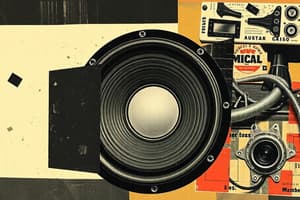Podcast
Questions and Answers
What is the primary function of filters in audio engineering?
What is the primary function of filters in audio engineering?
- To amplify all frequency responses equally
- To remove irrelevant noise and energy (correct)
- To solely enhance human perception of sound
- To increase energy in the audio system
What does the steepness of the falling edge of a filter indicate?
What does the steepness of the falling edge of a filter indicate?
- The frequency range of the filter
- The effectiveness of noise removal
- The type of audio signal being processed
- The order of the filter (correct)
What must be analyzed to determine the filter order from a frequency representation?
What must be analyzed to determine the filter order from a frequency representation?
- The overall gain of the system
- The frequency response curve at 0 dB
- The curve point where the level decreases by 3 dB (correct)
- The initial amplitude of the signal
Why is it important to consider the phase frequency response of a filter?
Why is it important to consider the phase frequency response of a filter?
Which of the following filter shapes is not typically one of the classic groups?
Which of the following filter shapes is not typically one of the classic groups?
How is the edge steepness of a filter typically expressed in audio engineering?
How is the edge steepness of a filter typically expressed in audio engineering?
Which option best describes the effect of distortion caused by filters?
Which option best describes the effect of distortion caused by filters?
Which function is specifically associated with a Low Cut filter?
Which function is specifically associated with a Low Cut filter?
Which type of filter is most commonly used in equalizers?
Which type of filter is most commonly used in equalizers?
What is the relationship between bandwidth and quality in a bell filter?
What is the relationship between bandwidth and quality in a bell filter?
What is NOT a characteristic of a fully parametric filter stage?
What is NOT a characteristic of a fully parametric filter stage?
What does the term 'quality' refer to in the context of a bell filter?
What does the term 'quality' refer to in the context of a bell filter?
Which type of filter has a fixed bandwidth (quality) but variable gain?
Which type of filter has a fixed bandwidth (quality) but variable gain?
What is the difference between a constant-Q filter and a variable-Q filter?
What is the difference between a constant-Q filter and a variable-Q filter?
Which of the following filter types is NOT typically found in equalizers?
Which of the following filter types is NOT typically found in equalizers?
What is the main difference between semi-parametric and fully parametric filter stages?
What is the main difference between semi-parametric and fully parametric filter stages?
Flashcards
Filter Types
Filter Types
Various types of filters used in audio signal processing, including Butterworth, Tschebyscheff, Cauer, and Bessel.
Equalizer
Equalizer
An audio tool that uses various filters to adjust frequency response.
Bell Filter
Bell Filter
A filter that boosts or cuts frequencies around a center frequency, defined by its quality factor (Q).
Notch Filter
Notch Filter
Signup and view all the flashcards
Quality Factor (Q)
Quality Factor (Q)
Signup and view all the flashcards
Bandwidth
Bandwidth
Signup and view all the flashcards
Parametric Filter
Parametric Filter
Signup and view all the flashcards
Constant Q Filter
Constant Q Filter
Signup and view all the flashcards
Filter
Filter
Signup and view all the flashcards
Purpose of Filters
Purpose of Filters
Signup and view all the flashcards
Sampling Theorem
Sampling Theorem
Signup and view all the flashcards
Phase Frequency Response
Phase Frequency Response
Signup and view all the flashcards
Filter Shapes
Filter Shapes
Signup and view all the flashcards
Low Pass Filter
Low Pass Filter
Signup and view all the flashcards
High Pass Filter
High Pass Filter
Signup and view all the flashcards
Filter Order
Filter Order
Signup and view all the flashcards
Study Notes
Filters
- Filters are essential in audio engineering, used for frequency adaptation and various functions
- In analog audio, they remove noise and unnecessary energy irrelevant to human perception
- Filters are crucial in digital processing, enabling adherence to the sampling theorem
- A filter's primary role often involves modifying the amplitude-frequency response, usually by targeting certain frequencies
- Filters invariably affect the phase frequency response, potentially causing waveform distortion, but this is often imperceptible
Filter Shapes
- Filters can be categorized into five main types: Low Pass/High Cut, Low Cut, Bandpass, Band-Stop/Band Rejection, and Allpass
- Choosing the appropriate filter name depends on its intended application
- A significant factor is the 'steepness' of the filter response's falling edge, typically measured in dB/octave
- Filter types are differentiated by order, with 'n' representing the filter order in relation to 6dB/octave
- Filters can be semi or fully parametric, with varying characteristics for filter frequency, gain and Q factor
Equalizers
- Equalizers make use of multiple, adjustable filters interacting together
- They permit precise manipulation of frequency responses
- Complex circuits are often used in equalizers, which cannot be perfectly replicated by passive filters
- Common equalizer filter types include Bell, Shelf/Shelving, Low and High Pass, and Notch filters.
Filter Parameters
- Filter characteristics depend on parameters like frequency, gain, or quality (Q).
- Bandwidth is related to Quality but has a different meaning (bandwidth being the difference between upper and lower frequencies and quality being the bandwidth divided by center frequency)
- Center frequency (fo) is calculated using the geometric mean of the upper and lower frequency limits, and not the arithmetic mean
- Q (Quality) is often constant in a filter for particular gain, but it can vary with gain in others, influencing the broader frequency range affected.
Studying That Suits You
Use AI to generate personalized quizzes and flashcards to suit your learning preferences.




